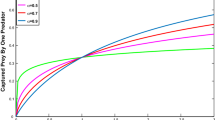Abstract
This paper deals with a testing problem for each of the interaction parameters of the Lotka–Volterra ordinary differential equations system~(ODE). In short, when the rates of birth and death are fixed, we would like to test if each interaction parameter is higher or lower than a fixed reference rate. We choose a statistical model where the actual population sizes are modelled as random perturbations of the solutions to this ODE. By assuming that the random perturbations follow correlated Ornstein–Uhlenbeck processes, we propose the uniformly most powerful test concerning each interaction parameter of the ODE and, we establish the asymptotic properties of the test. Further, we illustrate the suggested test on the Canadian mink–muskrat data set.
Similar content being viewed by others
References
Brockwell PJ and Davis RA (1991). Time series: theory and methods, 2nd edn. Springer, New York
Bulmer MG (1974). A statistical analysis of the 10-year cycle in Canada. J Anim Ecol 43: 701–718
Chen Z and Kulperger R (2005). A stochastic competing-species model and ergodicity. J Appl Prob 42(3): 738–753
Froda S and Colavita G (2005). Estimating predator–prey systems via ordinary differential equations with closed orbits. Aust NZ J Stat 2: 235–254
Froda S and Nkurunziza S (2007). Prediction of predator–prey populations modelled by perturbed ODE. J Math Biol 54: 407–451
Gard T (1988). Introduction to stochastic differential equations. Marcel Dekker, New York
Gard CT and Kannan D (1976). On a stochastic differential equation modeling of prey–predator evolution. J Appl Prob 13: 429–443
Ginzburg LR and Taneyhill DE (1994). Populations cycles of forest Lepidoptera : a maternal effect hypothesis. J Anim Ecol 63: 79–92
Ginzburg L, Colyvan M (2004) Ecological orbits : how planets move and populations grow. In: Applied biomathematics. Oxford University press, New York
Kendall BE, Briggs CJ, Murdoch WW, Turchin P, ellner SP, McCauley E, Nisbet R and Wood SN (1999). Why do populations cycle? A synthesis of statistical and mechanistic modelling approaches. Ecology 80(6): 1789–1805
Kutoyants AY (2004). Statistical inference for ergodic diffusion processes. Springer, New York
Lehmann EL and Romano JP (2005). Testing statistical hypotheses, 3rd edn. Springer, Heidelberg
Lotka AJ (1925). Elements of Physical Biology. Williams and Wilkins, Baltimore
Nkurunziza S (2005) Inférence statistique dans certains systèmes écologiques : système proie-prédateur. Ph.D Thesis. UQAM. Montreal
Perko L (1996). Differential equations and dynamical systems, 2nd edn. Springer, New York
Royama E (1992). Analytical population dynamics. Chapman & Hall, London
Spanjaard JM and White L (1995). Adaptive period estimation of a class of periodic random processes. IEEE 5: 1792–1795
Steele JM (2001). Stochastic calculus and financial applications. Springer, New York
Volterra V (1931) Leçons sur la théorie mathématique de la lutte pour la vie. Gauthiers-Villars
Whittle P (1954). Some recent contributions to the theory of stationary processes. In: Wold, H (eds) A study in the analysis of stationary time series., pp. Almqvist & Wiksell, Stockholm
Author information
Authors and Affiliations
Corresponding author
Additional information
This research has received the financial support from Natural Sciences and Engineering Research Council of Canada and Institut des Sciences Mathématiques.
Rights and permissions
About this article
Cite this article
Nkurunziza, S. Testing interaction in some predator–prey populations. Stat Papers 50, 527–551 (2009). https://doi.org/10.1007/s00362-007-0096-x
Received:
Revised:
Published:
Issue Date:
DOI: https://doi.org/10.1007/s00362-007-0096-x
Keywords
- Correlated Ornstein–Uhlenbeck process
- Ergodic and stationary process
- Gaussian process
- Wiener process
- Uniformly most powerful test
- Interaction parameter
- Lotka–Volterra ODE




